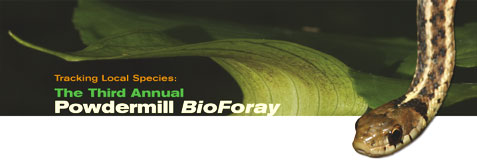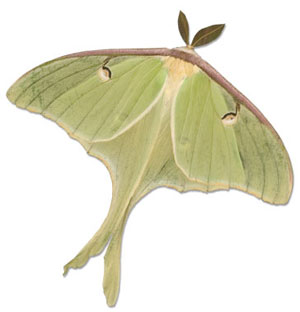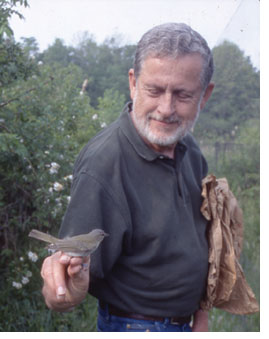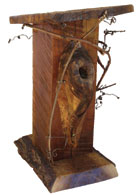
Eastern
garter snake, Thamnophis sirtalis, the most abundant snake
in
Pennsylvania.
R.J.
Gangewere To date, more than 200 acres of the Museum of Natural
History’s 2,200-acre nature reserve have been
surveyed during the 2002 and 2003 BioForays, providing
the beginnings of an impressive database that will
give scientists
an unprecedented tool for understanding and studying
the environment.
At the BioForay, amateur naturalists
are given the opportunity to work alongside field
scientists as they
survey and document where flora and fauna occur.
Past participants have included parents and their children,
retired individuals, schoolteachers, and other professionals—all
eager to gain an in-depth understanding of the natural
world.
 To conduct the survey, the area being researched
is divided into a grid of 50-meter squares. Then,
teams
of experts and amateur naturalists methodically
identify all the organisms found within each square
and record
their precise locations. Birds are identified by
their songs, mammals are live-trapped and released,
and small
animals such as insects and spiders are collected
for accurate species identification at the museum. To conduct the survey, the area being researched
is divided into a grid of 50-meter squares. Then,
teams
of experts and amateur naturalists methodically
identify all the organisms found within each square
and record
their precise locations. Birds are identified by
their songs, mammals are live-trapped and released,
and small
animals such as insects and spiders are collected
for accurate species identification at the museum.
Luna moth, Actius luna,
has a wing span up to 10.5 cm. In
June 2002, BioForay teams investigated two sites—one
at Furnace Woods and one at Powdermill Run. Scientists
and naturalists identified 665 species of plants,
animals, and fungi in 144 locations in the plots,
representing 1,592 different species localities.
Among the species
they found associated with each other were the
Magnolia
Warbler with Hemlock trees, and the silphid beetle
(Nicrophorus orbicollis) with the cranefly (Epiphragma
fascipennis). Knowing the relationships of species
within their habitats makes it easier to predict
how changes affecting one species influence other
species and their common environment.
Robert Davidson
of Carnegie Museum of Natural
History’s
Invertebrate Zoology department (bugs) points
out two ways of viewing data: first, see if
it provides a picture
of ecosystem health; second, use it to interpret
or predict other environmental features. Logging
companies in Pennsyl-vania
and other
states use scientific field-workers for background
surveys
before they harvest the trees to determine
if any endangered species are occurring in
an area. In
2003, the BioForay shifted to another area
of Powdermill Reserve along Weaver Mill Road,
which
included an old
strip mine and a sphagnum swamp. In 2004,
the BioForay will be held in an area of the Reserve
known as
the Friedline Mine.
Theresa Gay Rohall, coordinator of education
at Powdermill, notes that a
long-term goal of the BioForay at Powdermill
is to go beyond the boundaries of the nature
reserve
itself
and survey other areas of the region, thus
putting together a
broader picture of biodiversity in the Laurel
Highlands.
For more information about the BioForay,
call 724.593.6105, or visit the website
www.carnegiemuseums.org/cmnh/powdermill.
 A Half-Million A Half-Million
Birds Later...
Powdermill’s Senior Bird Bander
Retires
Western Pennsylvania's best-known bird bander, Robert
C. Leberman, has retired from full-time work at
Powdermill Nature Reserve after more than 42 years
of service
to Carnegie Museum of Natural History. He will
continue part-time with the program he established
while he
works on a new edition of his 1976 book, The Birds
of the Ligonier Valley, which he hopes to publish
during Powdermill’s 50th anniversary year in
2006. Robert C. Leberman with a Grey
Catbird. Photo: Mindy McNaugher
Bird
banding became Powdermill's signature scientific
program in 1961, after Leberman began his fieldwork
at the invitation of then museum director Dr. M.
Graham
Netting, under the direction of the museum's Section
of Birds.
Leberman was a pioneer in developing one
of the most productive, long-standing, and well-regarded
landbird
monitoring programs in North America. Initially
working outdoors, even bathing in the cold waters of
Powdermill
Run in the early years, Leberman for many years
banded birds in a tiny converted summer kitchen. He
finally
moved into a spacious, specially constructed banding
lab in the headquarters area of the reserve, where
the banding continues to this day.
To capture birds,
he used nearly invisible mist nets in a trap-and-release
technique that literally
has bagged a half-million birds for the program
during more than four decades of work.
Each of these
birds was carefully retrieved from the nets within
an hour of its capture, put into a paper bag
held closed by a color-coded clothespin, and returned
to the banding
station for processing. Bob recorded each bird’s
species, age, breeding condition, fat level,
and weight, after deftly attaching a tiny identifying
band to its
leg. Once banded and fully recorded, the birds
were quickly released through a small sliding
trap
door
in the window at the side of the banding desk.
In addition to the valuable data collected at
banding, information
is also recorded when the same banded birds are
recaptured in the nets at Powdermill days, months,
or even years
later. And inevitably, a small number of banded
birds are found each year at sites as far away
as Florida,
Costa Rica, and even California. Their Powdermill
origins are traced through the individually numbered
bands
that Bob originally attached.
Generations of
students and future bird-lovers were introduced
to ornithology and
ecology by watching Leberman work. Robert Mulvihill,
once a student intern at Powdermill, was led
into a career in field ornithology by the mentoring
he received
from Bob Leberman. “In the course of his career,
tens of thousands of visitors of all ages and from
every walk of life have been welcomed and educated
in Bob's easy way,” Mulvihill notes. “He
set the highest possible professional standard for
quality and quantity of data, and his diligent work
was always accompanied by an unflaggingly kind and
humble demeanor. It is impossible to overstate the
good will that Bob’s efforts have garnered for
Powdermill and for Carnegie Museum of Natural History.”
Exploring the “Evolving Miracle” of Hawaii
Remains of a Rainbow
 The rainbow is the hallmark of Hawaiian life, and the traveling
photographic exhibition Remains of a Rainbow captures the rich but
imperiled tapestry of life that is native to the Hawaiian Islands.
Sponsored by the Nature Conservancy of Hawaii, this stunning collection
of portraits of rare and endangered plants and animals is not intended
to memorialize species that will soon be extinct, but rather call
attention to their plight and provide a glimpse of how urban development,
pollution, and industrialization are taking a toll on Hawaii’s
native species and natural resources. The rainbow is the hallmark of Hawaiian life, and the traveling
photographic exhibition Remains of a Rainbow captures the rich but
imperiled tapestry of life that is native to the Hawaiian Islands.
Sponsored by the Nature Conservancy of Hawaii, this stunning collection
of portraits of rare and endangered plants and animals is not intended
to memorialize species that will soon be extinct, but rather call
attention to their plight and provide a glimpse of how urban development,
pollution, and industrialization are taking a toll on Hawaii’s
native species and natural resources.
Acclaimed wildlife photographers
David Liittschwager and Susan Middleton capture the beauty of nature
by isolating individual species on a
black or white backdrop. Flowers explode with color; insects are
illuminated; birds and fish stare back at the viewer, revealing
distinct personalities.
Remains of a Rainbow: Rare Plants and Animals
of Hawaii was the long-awaited third book by these two photographers,
published in
2001 by National
Geographic in association with Environmental Defense. More than
40 of the book's portraits are reproduced in the exhibit, which
also
has a 30-minute film documenting the astonishing Hawaiian environment.
After premiering at the Bishop Museum in Hawaii in January 2004,
the exhibit will open at Carnegie Museum of Natural History as
the first stop on its world tour.
Endangered species photographer
Susan Middleton says that she came to understand fully “the
evolutionary frenzy, the evolutionary miracle” that occurred
in the Islands, and the profound difference between what is native
or not-native in the environment. She saw
that the native plants and animals are the real expressions of
a place, and give it its unique character. Understanding that for
the
first time in Hawaii, she says, “changed my life utterly.”
Garden Themes & Birdhouse Dreams
Seventh Annual Benefit for Powdermill
Friday, May 28, 2004, 6 p.m. l Powdermill Nature Reserve
 As
has become the custom, Memorial Day weekend in the
Ligonier Valley will again be kicked off by the
popular celebration Garden Themes & Birdhouse Dreams.
Last year this fundraising event sold out and netted
nearly $50,000 to benefit the programs and facilities
at Powdermill Nature Reserve. As
has become the custom, Memorial Day weekend in the
Ligonier Valley will again be kicked off by the
popular celebration Garden Themes & Birdhouse Dreams.
Last year this fundraising event sold out and netted
nearly $50,000 to benefit the programs and facilities
at Powdermill Nature Reserve.
The event features a
silent auction of birdhouses and one-of-a-kind, garden-related
items, all created and
donated for the event by artisans of all ages from
western Pennsylvania and beyond. In addition, unique
items and opportunities are offered in a live auction.
The evening includes a reception, a buffet supper,
and special activities for children during the silent
and live auctions.
Over the last six months, adult
and child artists have created and donated a birdhouse
or a bird- or
garden-related
item to the auction. A panel of judges selects
the winners, who receive cash awards, medals, and gift
certificates. In addition, Patricia and Harvey
Childs
of G Squared Gallery, the event’s founders,
present a $500 award to the artist who designs
their personal
favorite. Artists are also honored at a special
artists’ reception.
Information about how to donate an item is available
at G Squared Gallery in Ligonier or on the event’s
website: www.birdhousedreams.com.
All the entries
will be on display in the Ligonier Valley Library’s
Art Gallery from May 21-27, and the public is invited
to visit the Gallery, look
at the items, and bid on them—especially
if a person is unable to attend the event on May
28.
Garden Themes & Birdhouse Dreams tickets
are $30 per person (with no charge for children
under 12) and
reservations can be made by calling Powdermill
at 724.593.6105. Space is limited to 350 reservations
and early reservations
are encouraged.
Architects Chosen for Dinosaurs in Their World
Carnegie
Museum of Natural History has selected E. Verner
Johnson and Associates of Boston and the Pittsburgh
office of Burt Hill Kosar Rittelmann Associates
for
its Dinosaurs in Their World expansion project.
The two firms were selected from a group of seven firms
that competed for the project. Museum Director
Bill
DeWalt points out that, “E. Verner Johnson
has an incredible breadth of experience working
on museum projects including several for Carnegie
Museums
of Pittsburgh. We are also very pleased they have
teamed up with Burt Hill Kosar Rittelmann. It was
very important to us to have a local company involved
in this project.”
The Dinosaurs in Their
World project is a $35 million expansion and
renovation to create additional space
for state of the art exhibits. The museum plans
to use its world-class collections to create dynamic
new exhibits, which, for the first time, will
integrate
dinosaurs into the environments of their respective
time periods.
Back to Contents |